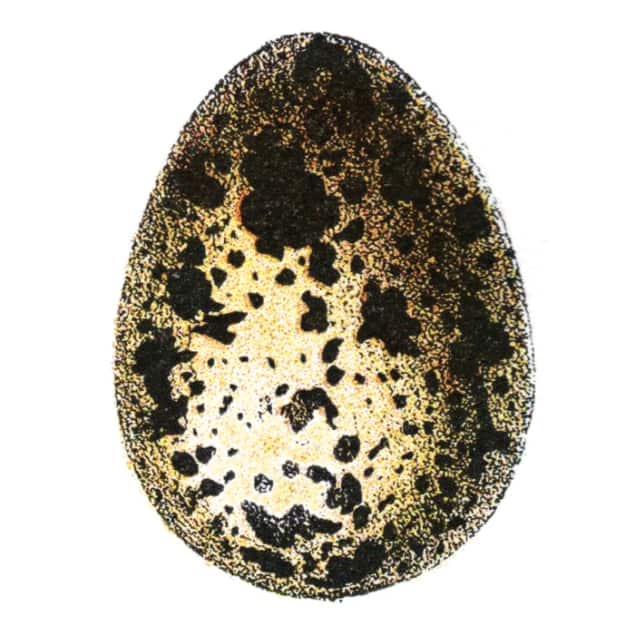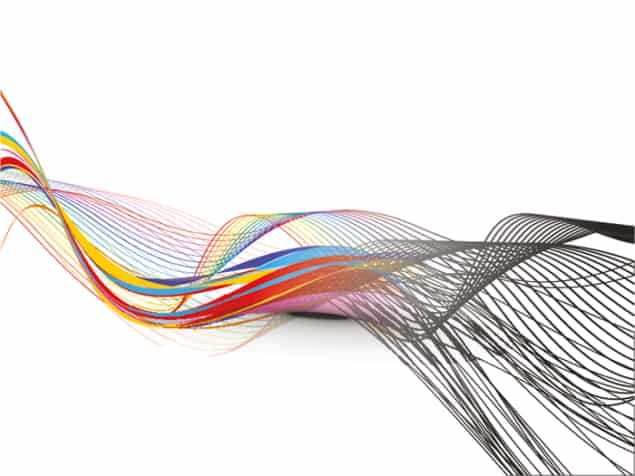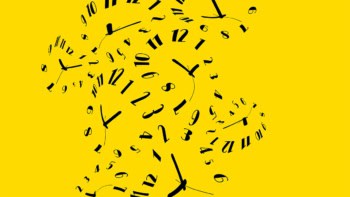Dispelling the myth of Eureka moments, Vitor Cardoso describes what he’s learned about how ideas in physics really come about, thanks to the essays penned by physicists in The Birth of an Idea – the web-based project he co-founded with artist Ana Sousa Carvalho

I’ve always wondered what triggered the great ideas. When I was a child, I often imagined that somewhere out there, there was a superior being whispering secrets to the chosen few – to those humans lucky enough to gain some special new insight into the world. Indeed, this view seemed to fit with stories such as Newton’s apple or Archimedes’ “Eureka!” moment, in which a serendipitous event precipitates some sudden epiphany. So notorious are these tales that they’ve become myths, used as a shorthand for those moments when our understanding of the world advances to a new level.
When we tell and retell the fall of that fateful apple, or of Archimedes’ bathtub revelation, it sometimes feels as if we are saying that this is how all scientific discoveries take place. But is it really? The truth is that science is built upon many untold smaller discoveries. But what do these smaller discoveries look like, and what leads each individual scientist to their own revelatory moment?
The nuclear question
These questions re-surfaced for me a few years ago during a conversation with artist Ana Sousa Carvalho. We were talking about scientific curiosity and its consequences. At a certain point in our discussion, she asked me if knowing everything we know now – and if given the chance – I would have helped to build the nuclear bomb. This was, of course, a hypothetical question, and my initial response was, “Yes, just out of curiosity.” My gut feeling was that I’d want to show myself that I could crack the problem.
On reflection, however, I became annoyed with myself for having had such a reaction and so I decided to research the history of the atomic bomb to find out more about the decisions the physicists involved faced at each step. While going over a few books, my attention drifted to the technical details, and I began to think that similar ideas could be used in gravitational physics. Well, this incursion eventually gave rise to new work and a scientific paper on instabilities in black-hole systems. This was also the first time in my role as a scientist that I found myself thinking in a serious manner about the way in which ideas come to life.
At the same time, Ana and I had been talking about the similarities between creativity in art and science. After some back and forth, we hit upon the idea of creating a repository of essays written by scientists describing the genesis of their ideas. It was our hope that these texts would eventually grow into an archive that would, with time, take the shape of an informal history of contemporary science, captured from a personal perspective. We felt that the project could be of interest not only to the scientific community, but to students and the general public as well. We called the project The Birth of an Idea) and set about asking the science community to share stories with us.
Our approach was very simple: to write to colleagues and ask them to write a short essay on the genesis of their ideas. It was important for us to emphasize that we weren’t interested solely in tales about breakthrough discoveries. We were also after the trivial and the ordinary, the small victories and the long struggles. As a physicist, I am well aware that this is the territory where most of us toil. It took a while for the project to get off the ground, but we put our focus on the physics community and so far the response has been amazing – we now have a collection of 64 essays in total, from physicists and astronomers in a diverse range of research fields and from countries the world over. We usually send out five requests a month and right now we have a success rate of roughly 30%. Unquestionably, most of the work lies on the contributing authors, who have been extraordinarily generous with their time and experiences.
Just have a bath
Reading the essays has been a rewarding experience – going over these first-hand accounts is like being granted a behind-the-scenes view of physics. From Roberto Emparan, we learn how the association between black-hole entropy and entanglement entropy was born while he put his son to sleep. Pauline Gagnon reveals in her account “Only women could think of it” the surprising way in which she and a female colleague managed to fix a detector at CERN. In some other great examples, Michele Vallisneri recounts how the work of Richard Feynman helped him to optimize gravitational-wave detection, and Andreas Warburton describes the discovery of the top quark. Two examples are given in full below.
Above all, these essays give the reader the human perspective. Each, in its own way, offers a glimpse into an incredible world that usually remains unseen. For instance, Eric Poisson’s contribution does a beautiful job of rendering the restlessness that comes with the struggle to understand a problem: “That night I walk the streets of downtown Milwaukee in a state of agitation. There is something wrong somewhere, and I have to get to the bottom of it.”
We hear from colleagues that they have their best ideas walking home or in bed or in the shower, and we can’t help but nod in agreement while reading Masaru Shibata when he tells us, with the concision of a haiku: “In my experience, ideas often come to me when I am taking a bath. Thus, I recommend taking a bath every day.” Perhaps there was something to Archimedes’ approach after all.
There are moments of elation, as in this experience described by Shahar Hod: “It was incredible to know that, at that moment, I was the only person in the Milky Way who knew the simple truth about the quantization of the black-hole horizon area: k = 3!” But most often, and perhaps by virtue of what Paolo Pani identifies in his essay as the sadistic nature of science, we watch these scientists as they confront the despair of witnessing their ideas die many deaths before they are finally allowed to get their hands on the reward.
Collective creativity
I had many personal conversations with colleagues who did not contribute because they claim that none of their ideas are original but stem from other ideas already in existence. These people make up a considerable fraction of the community and say that their work relies on conversations with colleagues, meetings and workshops. In fact, even some of the colleagues who did send in their contributions assert that the majority of their work gets done in groups, by talking to other colleagues. I find this fascinating, because it is a testament to the existence of a kind of collective creativity – a spontaneous brainstorming that happens when scientists meet.
This concept contradicts the widespread notion that science advances only in big leaps made by an individual, through new big ideas that materialize out of the blue before instantly crystallizing into their final form. As Nicolas Yunes puts it in his essay: “The image of the lonely genius with her or his ‘Aha!’ moment is an illusion. The birth of an idea is much more of a community activity than we sometimes care to acknowledge.”
- Vitor Cardoso and Ana Sousa Carvalho are currently looking for submissions. To submit your story, go to http://birthofidea.tecnico.pt or e-mail birth_of_idea@ist.utl.pt
The glimpse of an idea by Pedro Figueira

An idea is a neat little thing. Ideas can easily show up, uninvited, and disappear without warning. They are of such a fleeting nature that sometimes they seem to lead a life of their own.
For me, more interesting even than an idea, is the glimpse of an idea. Some ideas are big and clumsy, and what they lack in subtlety they compensate for with persistence. They look at us in the face until we look back. But others are far more elusive; we only feel they should be there. We look at something and think “well, that’s funny” or “this was not supposed to happen”, and frown or make a funny face. For a brief moment, the chaos of the world seems not to enter our ears as loudly as before, and we hear little gears grind in our head. When that happens we are at one end of a thread that, once followed, will take us to the feet of a new idea.
But too often we are too busy to care. Or simply forget, somehow, that an idea is something worth searching for, and only get the big, loud and persistent ones. My advice on the subject is: practise finding new ideas. Next time you feel the funny feeling and hear your gears grinding, focus. Do not let the moment fly away, unnoticed and unused. The thread is before you.
Do not wait for the ideas to come, go after them, and with a club. You will miss the first few, but that doesn’t matter. Experience will render your senses more acute, and practice will sharpen your hunting. Learn to examine your ideas against the background of evidence you have gathered, so that you can tell good from bad, useful from useless. As you do this, you will find not only a way of collecting good ideas, but the person you are will be changed by the quest.
And when you are struggling, remember: the truth will set you free, but first it will piss you off.
Pedro Figueira is a researcher at the Centro de Astrofísica da Universidade do Porto, Portugal
A journey by Djordje Minic

I would like to recall the foggy and emotional beginnings of an ongoing journey regarding the foundations of quantum gravity and string theory.
The idea that quantum gravity, in the guise of a novel formulation of string theory, should represent a new framework for physics that goes beyond (and also sheds light on) the current framework based on quantum theory (as well as its puzzling relation to the classical world), presented itself to me in a rather vague form in the fall of 1997 as I was moving from Chicago to State College.
I still remember the initial, almost tactile, sensation of excitement and elation, as well as the feeling of dread, of profound fear at being completely wrong and deluded. These initial contradictory emotions have since then become almost an obsession as well as a concrete research programme.
The most important aspect of the flowering of this initially misty notion is that many friends and collaborators have provided at least partial sanity checks to the original intuition. Perhaps the most exciting and concrete realization of the idea that quantum gravity/string theory is a new framework for physics has been realized in my recent work with two dear friends: Laurent Freidel and Rob Leigh.
It is still not clear where this journey will take us, but it has so far been a wonderful example of Antonio Machado’s “Traveller, there is no path/The path is made by walking.”
Djordje Minic is a professor of physics at Virginia Tech, US



